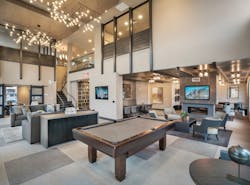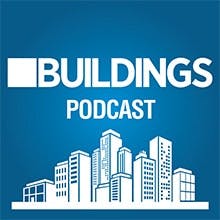“The present is pregnant with the future,” Voltaire famously remarked centuries ago. His sage observation holds true today vis-à-vis 2019’s top commercial interior design trends. The most significant developments in the field became evident in 2018 and will dominate the landscape in 2019 as well: the rising importance of psychographics, sustainability, wellness, community and authenticity.
Gone are the days when commercial interior designers put color palettes, design styles and furnishings first. The primary focus when designing public and private spaces in residential developments, hospitality settings and offices must be ESG—the environmental, social and governance aspects of a project.
This is also crucial for facility owners and managers to understand so they can help bring these elements into their buildings.
ESG in Commercial Interior Design
Investors use ESG to determine if a company is socially conscious. It has morphed from a benchmark for investment performance to a measure many industries are using to gauge sustainability.
The Urban Land Institute’s 2019 Emerging Trends in Real Estate report showed that ESG is now front-and-center in the commercial real estate industry due to:
- Rising costs of natural resources and building materials
- Fear of market saturation
- The changing nature of many industries, from hospitality to retail
For commercial interior designers, fundamentals such as target markets, functionality and structural resilience must be considered with respect to usage, and ultimately tied to a project’s interior design long before the structure breaks ground.
In truth, doing so helps designers and all project team members focus on “getting it right” to spur conversion and ensure buildings fulfill their potential.
Take a Solutions-based Approach to Interior Design
Also, these trends signal that all members of the team—from architects and commercial interior designers to developers and builders—must embrace design thinking, the solutions-based approach to the craft.
Developing a codified system accounts for five fundamentals. This system requires you to document intentional efforts to fulfill each fundamental on a project as it progresses. Many builders and developers don’t realize what each of these trends entail, especially when it comes to commercial interior design.
Here are 5 ways they impact projects:
1. Psychographics
Unlike demographics, which have always informed the design process, psychographics are qualitative rather than quantitative and require a far deeper “discovery process.” What are the attitudes, values, interests and lifestyles of a project’s users, be it an office, restaurant, hotel or multifamily building?
Users’ origins, ethnicities, family backgrounds, culture, education levels, professions and more inform these characteristics. Coupled with demographics—gender, age, income, educational level, marital status and race—these help designers understand for whom they’re designing and what they need and want.
When a building is unpopular or underused, that means something about its design doesn’t resonate with its target markets.
2. Sustainability
Today, green building has gone from an ambition to a standard, and every structure or development we work on is built with leaner, greener building techniques—often executed in conjunction with meeting one or several specific green building standards.
But green building techniques are only part of what goes into making structures sustainable.
[Related: 10 Tips for Green Building Certification]
It is also critical to use design strategies that won’t compromise residents’ health and design environments that embrace renewable, recyclable and low-waste building materials and systems.
Rather than building “green,” a designer’s goal must be to create spaces and communities that allow people to live better now and in the future.
3. Wellness
“Our homes, communities and surrounding environment… determine up to 90 percent of our health outcomes,” a 2018 report from The Global Wellness Institute says.
[Read also: 5 Ways IoT Changes the Game for Multifamily Facilities]
Since many people work outside of their homes, it’s safe to say work environments are equally important for their health. And this means the buildings interior designer professionals design must encourage proactive behaviors and habits that drive wellness, from encouraging users to be active to helping them forge social connections.
Strategies can be as elementary as making stairwells pretty so users will forego elevators.
4. Community
“Mounting evidence shows that relationships should be a public health priority,” Scientific American reports. Loneliness is a public health crisis more critical than obesity and as significant as smoking and drinking, as noted by popular Washington political site The Hill.
Social connectivity is the solution, and it has a deep and positive impact on health and wellness.
And physical environments set the stage to inviting or impeding social interaction, the American Society on Aging points out.
[Related: 5 Things to Consider When Turning Your Rooftop into Usable Space]
This makes it critical for commercial interior designers to create spaces in buildings that cause occupants to interact with each other and build community.
5. Authenticity
Establishing authenticity in projects has become a critical part of making homes, offices, restaurants and hotels feel warm, welcoming, relaxing and comfortable.
To achieve this, designers must find ways to balance the artificial connections forged online with the natural experiences generated by live relationships and activities.
This means commercial interior designers must integrate character-rich yet relevant design elements into buildings, which can range from incorporating local materials and vernacular features into structures to commissioning art for community spaces that pay homage to a community or locale.
Architectural Salvage: Benefits of Reusing Old Buildings
Empty, decaying buildings are an eyesore – but demolishing them means valuable, reusable materials take up space in a local landfill.
Learn more...
Ensuring these design trends are being met in your building helps you remain competitive within the industry.
Two handpicked articles to read next:

